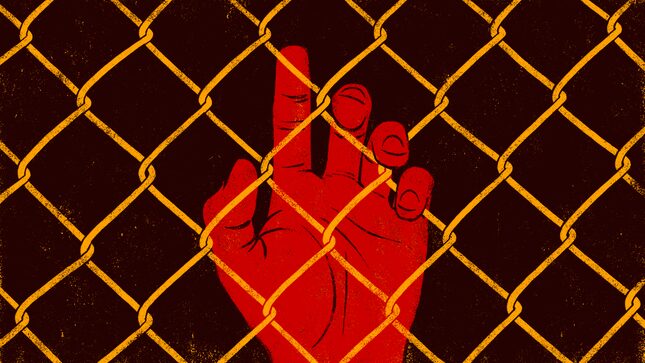A Theory of Animals
Latest
Illustration: Jim Cooke
I try to avoid listening to Donald Trump’s voice, but on a Wednesday in mid-May, I watched the video of a statement he made during a roundtable discussion about California’s sanctuary state policies. His exact words were:
“We have people coming into the country, or trying to come in—we’re stopping a lot of them. You wouldn’t believe how bad these people are. These aren’t people, these are animals, and we’re taking them out of the country at a level and at a rate that’s never happened before.”
Immediately, both conservatives and liberals jumped to his defense on the basis of context, because he had previously been talking about the MS-13 gang. These justifications are hollow. Criminals are human; I grew up Catholic, then evangelical, so I can tell you I learned that one from Jesus. It’s also fruitless to analyze the words of a man who speaks in non-sequiturs, whose brain apparently functions at the level of images that remind him of other images. Coming from the person who has said repeatedly that immigrants are rapists and criminals, the “people coming into the country” are the same person. They deserve the same treatment. Animals, all.
I’ve spent the past couple of years writing a book about undocumented immigrants around the United States. I tell the stories of undocumented second-responders after 9/11 and Hurricane Sandy, day laborers on street corners and worker centers, South American housekeepers who came to feminism in middle age. I write about immigration because I think almost everyone who writes about immigrants gets it wrong. I’d know. My family is undocumented. I came to the United States when I was five years old and was undocumented until recently, when I became a permanent resident.
When I heard Donald Trump compare undocumented immigrants to animals, I felt gutted. I took to bed and licked my wounds, a beastly thing to do. But there is not a lot of time to swim around in your own wounds when you’re an immigrant who works around the clock to help your family survive, to help so many families survive. So I cried the predetermined number of tears I had allowed myself then began to work on this, my theory of the animal.
among young Latinx immigrants, after the Trump comments went viral, there was some radical reclaiming of the word “animal” that piqued my interest.
Trump didn’t name a species in particular, either in his speech or in the alarming White House missive, because no one species of animal has been used as a slur towards undocumented immigrants. He said “animals.” And for “animals” to be understood by everyone as an insult, it means we have agreed as a society that animals are not only inferior to us, but that we have a certain ability to cause them pain, that it is our natural right—to starve them, slaughter them, rape them, brand them. One morning, after reading about one of Trump’s executive orders, I turned to my partner and said, “This is a man who has never loved an animal.”
But among young Latinx immigrants, after the Trump comments went viral, there was some radical reclaiming of the word “animal” that piqued my interest. In particular, there was a video of a fifth-grade girl whose father was deported and who gave an impassioned speech in which she said, “The president says Mexican immigrants are animals. We are not animals! But if I was, I’d be a black panther, fighting against racism and inequality!” The crowd roared.
I’ve heard a lot of border crossing stories. I could never cross the desert. Probably neither could you, unless you did, in which case you know that what you did is something extraordinary that goes against the course of evolution itself. The desert was not meant for us. On a hot day in the desert, a person can lose over three gallons of water through sweat. The Sonoran desert can get up to 120 degrees Fahrenheit during the day in the summer, and scientists who set foot in this desert, North America’s hottest, will hear a silence so deafening that one of them mused, “I wonder, did all the animals just suppress all of their behavior for the rest of the summer, or are they just dead?” But they’re not dead. There are some 60 species of mammals, 350 kinds of birds, 20 different types of amphibians, and approximately 100 reptiles in the Sonora. They’re all just laying low, doing their best to survive.
They say we live in the shadows. That’s the metaphor the media likes to use about undocumented immigrants. It never made sense to me. We’re everywhere. When I go to my neighborhood in Queens, we’re not scurrying in corners avoiding sunlight; the women are getting their hair blown out in Dominican salons and the men are wearing bright soccer jerseys and taking their kids out to ice cream. And I look at those kids and think, goddamn, you’re going to grow up to get higher SAT scores than poor Jared Kushner did, bless his heart, and you’re going to tell your kids and your kids’ kids’ that the solution to every ailment is chamomile tea. And so our people live. I like to think of us as beautiful birds who live perched on very tall branches of very tall trees. We’ve made it so that you can’t find us but our world is rich.
-

-

-

-

-

-

-

-

-

-

-

-

-

-

-

-

-

-

-

-

-

-

-

-

-

-

-

-

-

-

-

-

-

-

-

-

-

-

-

-








































